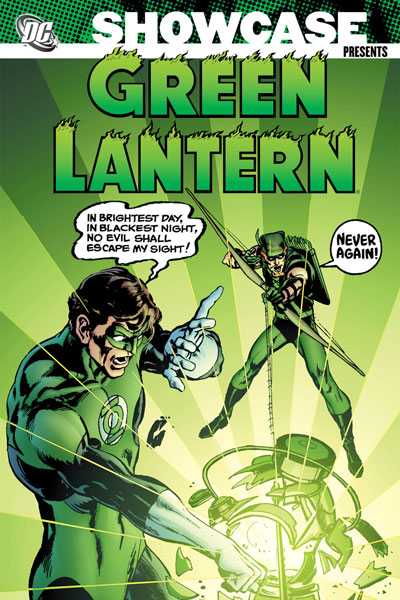Showcase Presents Green Lantern 5
Reviewed by Martin Skidmore 02-May-11
They have the back cover blurb right on this: it’s the run of Neal Adams Green Lantern & Green Arrow issues, nearly 350 pages, that will sell this. They call it one of the “most celebrated runs by a creative team in the history of comic books,” and they’re right – except it was also the run that led to the cancellation of the series because of dropping sales, after which GL became a backup story in broken runs in Flash.
Reprinting Green Lantern 76-89 and Green Lantern backup stories from Flash 217-246.
They have the back cover blurb right on this: it’s the run of Neal Adams Green Lantern & Green Arrow issues, nearly 350 pages, that will sell this. They call it one of the “most celebrated runs by a creative team in the history of comic books,” and they’re right – except it was also the run that led to the cancellation of the series because of dropping sales, after which GL became a backup story in broken runs in Flash.
There are reasons to admire Adams’ art: he certainly drew more realistically than anyone else in comic books then, taking lessons and techniques from newspaper strips and advertising art; and he had a strong compositional and design sense, in particular paying an unusual amount of attention to striking page layouts, sometimes brilliantly. On the other hand, he bugs the hell out of me for the bad moments, the panels that you can’t make sense of, the fancy page designs that you have to read, then work out what order you should have read it in, then read it again. These always strike me as gigantic flaws, and they are on show here. For example, on page 20 of the first story, I read the final panels in the wrong order first time, and it still looks to me to be the only natural order. Then on page 2 of the second story, I can find no reading of the fourth panel except that Green Arrow is lifting a jeep, which clearly can’t be the case. It’s also worth noting that only a few of the stories are inked as well as pencilled by Adams, though Giordano is a good sub on most of the rest.
I’m also against the valorising of realism as if it is inherently better than more cartoony art: I can see no reason why realism in itself is something to strive for. It’s limited anyway – you obviously can’t get a genuine kind of photorealism from inked drawing, since for a start people don’t actually have lines defining their edges. More importantly, for me, is the unimportance of realism to such a fundamentally unrealistic genre as superheroes.
On the other hand, it fits these stories unusually well, since O’Neil is aiming for a kind of social realism then new to superhero comics, dealing with money and racism and overpopulation rather than GL’s traditionally more cosmic superfoes. This is an admirable thing to try, to address social issues in a relatively honest and unflinching style rather than just giving us more big fights and tricky solutions, and there was a fresh forcefulness to these stories back then, not entirely dissipated by decades of others doing the same kind of thing since. There is however also a crude clumsiness in these early ‘relevant’ stories, which do often feel didactic, and despite repeated dialogue about complex shades of grey, there really aren’t many of those to be seen. I wish more of them were a bit more nuanced, that you didn’t sometimes feel you were being bludgeoned, admittedly with pretty sound ideas. The conflicts between GL and GA are often overly contrived and unconvincing too.
I have a reasonably high opinion of Denny O’Neil’s writing, and the ambition on show here is worth real respect, but actually my favourite story in this whole volume is the only one not written by him, a Green Arrow backup by the underappreciated Elliot Maggin, which takes Oliver Queen off in a new direction, and makes no attempts to offer solutions, while presenting incomprehensibly difficult problems.
Having been kind of grudging about the highly rated stories that make up most of this volume, I should add that the remainder are worse. Adams is replaced by Giordano, Dillin and Grell, none of whom make his annoying slips, but none have his force or drama or originality, so are far less exciting. O’Neil soon abandons any attempts at addressing social issues in favour of the kind of gimmicky SF that preceded his run, presumably because despite the critical reaction, relevance was not selling. GL even gets a little alien pal in the last half dozen stories here, which hardly helps matters.
I suspect as a buyer’s guide this review is pointless – the Adams stories are famous, and I’m sure everyone knows whether they want them or not. I think he and they are overvalued a lot, but they do make a change amongst the lightweight stories elsewhere at DC, in particular, from that time, and they have some real virtues.
Tags: DC, Denny O'Neil, Green Arrow, Green Lantern, Neal Adams, Showcase
This year’s reprinting of GA/GL #76-89 !
Martin, could you confirm the contents post #89, please ?
I’ve seen the contents advertised as #76-100, leading to the obvious comments of where are the back-up strips from the Flash, pre-#90 ?
Whereas your listing above suggests that it does include – and only go up to the end of – those back-up strips. This of course makes more sense.
I can confirm that the listing at the top of the review here is correct.
Thank you.